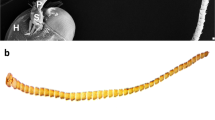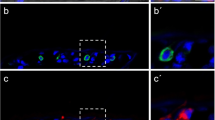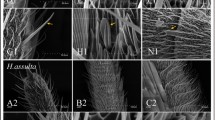Summary
Odorant-binding proteins are supposed to play an important role in stimulus transport and/or inactivation in olfactory sense organs. In an attempt to precisely localize pheromone-binding protein in the antenna of moths, post-embedding immunocytochemistry was performed using an antiserum against purified pheromone-binding protein of Antheraea polyphemus. In immunoblots of antennal homogenates, the antiserum reacted exclusively with pheromone-binding protein of A. polyphemus, and cross-reacted with homologous proteins of Bombyx mori and Autographa gamma. On sections of antennae of male A. polyphemus and B. mori, exclusively the pheromone-sensitive sensilla trichodea are labelled; in A. gamma, label is restricted to a subpopulation of morphologically similar sensilla trichodea, which indicates that not all pheromone-sensitive sensilla contain the same type of pheromone-binding protein and accounts for a higher specificity of pheromone-binding protein than hitherto assumed. Within the sensilla trichodea, the extracellular sensillum lymph of the hair lumen and of the sensillum-lymph cavities is heavily labelled. Intracellular label is mainly found in the trichogen and tormogen cells: in endoplasmic reticulum, Golgi apparatus, and a variety of dense granules. Endocytotic pits and vesicles, multivesicular bodies and lysosome-like structures are also labelled and can be observed not only in these cells, but also in the thcogen cell and in the receptor cells. Cell membranes are not labelled except the border between thecogen cell and receptor cell and the autojunction of the thecogen cell. The intracellular distribution of label indicates that pheromone-binding protein is synthesized in the tormogen and trichogen cell along typical pathways of protein secretion, whereas its turnover and decomposition does not appear to be restricted to these cells but may also occur in the thecogen and receptor cells. The immunocytochemical findings are discussed with respect to current concepts of the function of pheromone-binding protein.
Similar content being viewed by others
References
Arn H, Tóth M, Priesner E (1986) List of sex pheromones of Lepidoptera and related attractants. OILB-SROP, Paris
Batteiger B, Newhall WJ, Jones RB (1982) The use of Tween 20 as a blocking agent in the immunological detection of proteins transferred to nitrocellulose membranes. J Immunol Methods 55:297–307
Boeckh J, Kaißling K-E, Schneider D (1960) Sensillen und Bau der Antennengeißel von Telea polyphemus (Vergleiche mit weiteren Saturniden: Antheraea, Platysamia und Philosamia). Zool Jb Anat 78:559–584
Boeckh J, Kaissling K-E, Schneider D (1965) Insect olfactory receptors. Cold Spring Harb Symp Quant Biol 30:263–280
Bradford MM (1976) A rapid and sensitive method for the quantitation of microgram quantities of protein utilizing the principle of protein-dye binding. Anal Biochem 72:248–254
Breer H, Krieger J, Raming K (1990) A novel class of binding proteins in the antennae of the silk moth Antheraea pernyi. Insect Biochem 20:735–740
Danscher G (1981) Localization of gold in biological tissue ... a photochemical method for light and electronmicroscopy. Histochemistry 71:81–88
Dunkelblum E, Gothilf S (1983) Sex pheromone components of the gamma moth, Autographa gamma (L.) (Lepidoptera: Noctuidae). Z Naturforsch 38c:1011–1014
Ernst K-D (1969) Die Feinstruktur von Riechsensillen auf der Antenne des Aaskäfers Necrophorus (Coleoptera). Z Zellforsch Mikrosk Anat 94:72–102
Getchell TV, Margolis FL, Getchell ML (1984) Perireceptor and receptor events in vertebrate olfaction. Prog Neurobiol 23:317–345
Gnatzy W, Mohren W, Steinbrecht RA (1984) Pheromone receptors in Bombyx mori and Antheraea pernyi. II. Morphometric analysis. Cell Tissue Res 235:35–42
Györgyi TK, Roby-Shemkovitz AJ, Lerner MR (1988) Characterization and cDNA cloning of the pheromone-binding protein from the tobacco hornworm, Manduca sexta: a tissue-specific developmentally regulated protein. Proc Natl Acad Sci USA 85:9851–9855
Heinbockel T, Kaissling K-E (1990) Sensitivity and inhibition of antennal benzoic-acid receptor cells of female silkmoth Bombyx mori L. Verh Dtsch Zool Ges 83:411
Henke K (1953) Über Zelldifferenzierung im Intergument der Insekten und ihre Bedingungen. J Embryol Exp Morphol 1:217–226
Kaissling K-E (1986) Chemo-electrical transduction in insect olfactory receptors. Annu Rev Neurosci 9:121–145
Kaissling K-E (1987) R.H Wright lectures on insect olfaction. Simon Fraser University, Burnaby, Canada
Kaissling K-E, Priesner E (1970) Die Riechschwelle des Seidenspinners. Naturwissenschaften 57:23–28
Kanaujia S, Kaissling K-E (1985) Interactions of phermone with moth antennae: adsorption, desorption and transport. J Insect Physiol 31:71–81
Kasang G, Kaissling K-E (1972) Specificity of primary and secondary olfactory processes in Bombyx antennae. In: Schneider D (ed) Olfaction and taste IV. Wissenschaftliche Verlagsgesellschaft, Stuttgart, pp 200–206
Kasang G, Proff L von, Nicholls M (1988) Enzymatic conversion and degradation of sex pheromoes in antennae of the male silkworm moth Antheraea polyphemus. Z Naturforsch 43c:275–284
Kasang G, Nicholls M, von Proff L (1989) Sex pheromone conversion and degradation in antennae of the silkworm moth Bombyx mori L. Experientia 45:81–87
Keil TA (1982) Contacts of pore tubules and sensory dendrites in antennal chemosensilla of a silkmoth: demonstration of a possible pathway for olfactory molecules. Tissue Cell 14:451–462
Keil TA (1984a) Reconstruction and morphometry of silkmoth olfactory hairs: a comparative study of sensilla trichodea on the antennae of male Antheraea polyphemus and Antheraea pernyi (Insecta, Lepidoptera). Zoomorphology 104:147–156
Keil TA (1984b) Surface coats of pore tubules and olfactory sensory dendrites of a silkmoth revealed by cationic markers. Tissue Cell 16:705–717
Keil TA (1989) Fine structure of the pheromone-sensitive sensilla on the antenna of the hawkmoth, Manduca sexta. Tissue Cell 21:139–151
Keil TA, Steinbrecht RA (1984) Mechanosensitive and olfactory sensilla of insects. In: King RC, Akai H (eds) Insect ultrastructure, vol 2. Plenum, New York, pp 477–516
Keil TA, Steinbrecht RA (1987) Diffusion barriers in silkmoth sensory epithelia: application of lanthanum tracer to olfactory sensilla of Antheraea polyphemus and Bombyx mori. Tissue Cell 19:119–134
Keil TA, Steiner C (1991) Morphogenesis of the antenna of the male silkmoth, Antheraea polyphemus. III. Development of olfactory sensilla and the properties of hairforming cells. Tissue Cell 23:821–851
Kelly RB (1985) Pathways of protein secretion in eukaryotes. Science 230:25–32
Kemler R, Schwarz H (1989) Ultrastructural localization of the cell adhesion molecule uvomorulin using site-directed antibodies. In: Laat SW de, Bluemink JG, Mummery CR (eds) Cell to cell signals in mammalian development. NATO ASI Series, vol 26 Springer, Berlin Heidelberg, pp 145–152
Klein U (1987) Sensillum-lymph proteins from antennal olfactory hairs of the moth Antheraea polyphemus (Saturniidae). Insect Biochem 17:1193–1204
Krieger J, Raming K, Breer H (1991) Cloning of genomic and complementary DNA encoding insect pheromone binding proteins: evidence for microdiversity. Biochim Biophys Acta 1088:277–284
Kyhse-Andersen J (1984) Electroblotting of multiple gels: a simple apparatus without buffer tank for rapid transfer of proteins from polyacrylamide to nitrocellulose. J Biochem Biophys Methods 10:203–209
Laemmli UK (1970) Cleavage of structural proteins during the assembly of the head of bacteriophage T4. Nature 227:680–685
Meng LZ, Wu CH, Wicklein M, Kaissling K-E, Bestmann HJ (1989) Number and sensitivity of three types of pheromone receptor cells in Antheraea pernyi and Antheraea polyphemus. J Comp Physiol [A] 165:139–146
Palade G (1975) Intracellular aspects of the process of protein synthesis. Science 189:347–358
Pelosi P, Baldaccini NE, Pisanelli AM (1982) Identification of a specific olfactory receptor for 2-isobutyl-3-methoxypyrazine. Biochem J 201:245–248
Pevsner J, Snyder SH (1990) Odorant-binding protein: odorant transport function in the vertebrate nasal epithelium. Chem Senses 15:217–222
Pevsner J, Sklar PB, Snyder SH (1986) Odorant-binding protein: localization to nasal glands and secretions. Proc Natl Acad Sci USA 83:4942–4946
Pevsner J, Reed RR, Feinstein PG, Snyder SH (1988) Molecular cloning of odorant-binding protein: member of a ligand carrier family. Science 241:336–339
Plattner H (1989) Regulation of membrane fusion during exocytosis. Int Rev Cytol 119:197–286
Priesner E (1979) Progress in the analysis of pheromone receptor systems. Ann Zool Ecol Anim 11:533–546
Priesner E (1980) Sensory encoding of pheromone signals and related stimuli in male moths. In: Insect neurobiology and insecticide action (Neurotox 79). Society of Chemical Industry, London, pp 359–366
Raming K, Krieger J, Breer H (1989) Molecular cloning of an insect pheromone-binding proteins, FEBS Letters 256:215–218
Raming K, Krieger J, Breer H (1990) Primary structure of a pheromone-binding protein from Antheraea pernyi: homologies with other lignad-carrying proteins. J Comp Physiol [B] 160:503–509
Schneider D (1984) Insect olfaction—Our research endeavor. In: Dawson WW, Enoch JM (eds) Foundations of sensory science. Springer, Berlin Heidelberg New York, pp 381–418
Schneider D, Kaißling K-E (1957) Der Bau der Antenne des Seidenspinners Bombyx mori L. II Sensillen, cuticulare Bildungen und innerer Bau. Zool Jb Anat 76:223–250
Schneider D, Lacher V, Kaissling K-E (1964) Die Reaktionsweise und das Reaktionspektrum von Riechzellen bei Antheraea pernyi (Lepidoptera, Saturniidae). Z Vergl Physiol 48:632–662
Steinbrecht RA (1969) Comparative morphology of olfactory receptors. In: Pfaffman C (ed) Olfaction and taste III. Rockefeller University Press, New York, pp 3–21
Steinbrecht RA (1970) Zur Morphometrie der Antenne des Seidenspinners, Bombyx mori L: Zahl und Verteilung der Riechsensillen (Insecta, Lepidoptera). Z Morph Tiere 68:93–126
Steinbrecht RA (1973) Der Feinbau olfaktorischer Sensillen des Seidenspinners (Insecta, Lepidoptera): Rezeptorfortsätze und reizleitender Apparat. Z Zellforsch Mikrosk Anat 139:533–565
Steinbrecht RA (1980) Cryofixation without cryoprotectants. Freeze substitution and freeze etching of an insect olfactory receptor. Tissue Cell 12:73–100
Steinbrecht RA (1984) Chemo-, hygro-, and thermoreceptors. In: Bereiter-Hahn J, Matoltsy AG, Richards KS (eds) Biology of the integument, vol 1: Invertebrates. Springer, Berlin Heidelberg New York, pp 523–553
Steinbrecht RA (1985) Recrystallization and ice-crystal growth in a biological specimen, as shown by a simple freeze substitution method. J Microsc 140:41–46
Steinbrecht RA (1987) Functional morphology of pheromone-sensitive sensilla. In: Prestwich GD, Blomquist GJ (eds) Pheromone biochemistry. Academic Press, Orlando, pp 353–384
Steinbrecht RA (1992a) Experimental morphology of insect olfaction — tracer studies, X-ray microanalysis, autoradiography, and immunocytochemistry with silkmoth antennae. J Electron Microsc Res Techn (in press)
Steinbrecht RA (1992b) Stimulus transport and inactivation in insect olfactory sensilla-functional morphology, tracer experiments, and immunocytochemistry. In: Singh RN (ed) Neurobiology: principles of design and function. Wiley Eastern, New Delhi, pp 417–436
Steinbrecht RA (1992c) Freeze-substitution for morphological and immunocytochemical studies in insects. J Electron Microsc Res Techn, in press
Steinbrecht RA, Gnatzy W (1984) Pheromone receptors in Bombyx mori and Antheraea pernyi. I. Reconstruction of the cellular organization of the sensilla trichodea. Cell Tissue Res 235:25–34
Steinbrecht RA, Müller B (1971) On the stimulus conducting structures in insect olfactory receptors. Z Zellforsch Mikrosk Anat 117:570–575
Steinbrecht RA, Keil TA, Ozaki M, Maida R, Ziegelberger G (1991) Immunocytochemistry of pheromone binding protein. In: Elsner N, Penzlin H (eds) Synapse-Transmission-Modulation, Proceedings of the 19th Göttingen neurobiology Conference. Thieme, Stuttgart New York, p 172
Thurm U, Küppers J (1980) Epithelial physiology of insect sensilla. In: Locke M, Smith DS (eds) Insect biology in the future. Academic Press, New York, pp 735–763
Van den Berg MJ, Ziegelberger G (1991) On the function of the pheromone binding protein in the olfactory hairs of Antheraea polyphemus. J Insect Physiol 37:79–85
Vogt RG (1987) The molecular basis of pheromone reception: its influence on behavior. In: Prestwich GD, Blomquist GJ (eds) Pheromone biochemistry. Academic Press, Orlando, pp 385–431
Vogt RG, Riddiford LM (1981) Pheromone binding and inactivation by moth antennae. Nature 293:161–163
Vogt RG, Riddiford LM (1986) Pheromone reception: a kinetic equilibrium. In: Payne TL, Birch MC, Kennedy CEJ (eds) Mechanisms in insect olfaction. Clarendon, Oxford, pp 201–208
Vogt RG, Riddiford LM, Prestwich GD (1985) Kinetic properties of a sex pheromone-degrading enzyme: the sensillar esterase of Antheraea polyphemus. Proc Natl Acad Sci USA 82:8827–8831
Vogt RG, Köhne AC, Dubnau JT, Prestwich GD (1989) Expression of pheromone binding proteins during antennal development in the gypsy moth Lymantria dispar. J Neuroscience 9:3332–3346
Vogt RG, Prestwich GD, Lerner MR (1991) Odorant-binding-protein subfamilies associate with distinct classes of olfactory receptor neurons in insects. J Neurobiol 22:74–84
Williams JLD (1988) Nodes on the large pheromone-sensitive dendrites of olfactory hairs of the male silkmoth, Antheraea polyphemus (Cramer) (Lepidoptera: Saturniidae). Int J Insect Morphol Embryol 17:145–151
Author information
Authors and Affiliations
Rights and permissions
About this article
Cite this article
Steinbrecht, R.A., Ozaki, M. & Ziegelberger, G. Immunocytochemical localization of pheromone-binding protein in moth antennae. Cell Tissue Res 270, 287–302 (1992). https://doi.org/10.1007/BF00328015
Received:
Accepted:
Issue Date:
DOI: https://doi.org/10.1007/BF00328015




